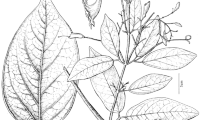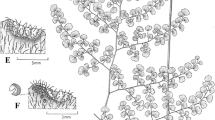Abstract
Schrankia nuttalii flowers through late spring on the tallgrass prairie. Although each stem produces an average of 26 capitate inflorescences only 12% of those inflorescences will open each day to disperse and receive polyads. Each inflorescence may live up to 48 hours but anthers abscise by late afternoon on the first day and the filaments change color and lose their scent. The 78–93 florets comprising each inflorescence open synchronously before dawn or during early morning hours. First day inflorescences ofS. nuttallii are herkogamous and fragrant. They are nectarless. Bombyliid flies and male bees are infrequent floral foragers so the major pollinators include female bees representing five families;Anthophoridae, Apidae, Colletidae, Halictidae, andMegachilidae. All foraging insects ignore second day inflorescences although stigmas are still receptive. Although 97% of all bees collected onS. nuttallii carrySchrankia polyads in their scopae or corbiculae 59% also carry the pollen/pollinaria of one or more coblooming angiosperms. At least 98% of all bees carrying mixed pollen loads incorporate the pollen/pollinaria of one or more nectariferous taxa (e.g.Asclepias spp.,Asteraceae, Convolvulaceae, Delphinium spec., etc.). Species of halictid bees are more likely to carry pure loads ofS. nuttallii polyads (70%) than bees of the four remaining families. Due to the nectarless florets and high degree of polylectic foraging bee-pollination inS. nuttallii converges more closely with the pollination systems of some AustralianAcacia spp. than with most other xeric/tropical genera of mimosoids studied in the western hemisphere.
Similar content being viewed by others
References
Arroyo, M. T. K., 1981: Breeding systems and pollination biology inLeguminosae. — InPolhill, R. M., Raven, P. H., (Eds.): Advances in legume systematics 2, pp. 723–769. — Kew: Royal Botanic Gardens.
Barkley, T. M., (Ed.), 1986: Flora of the Great Plains. The Great Plains Association. — Lawrence, Kans.: University Press of Kansas.
Bernhardt, P., 1987: A comparison of the diversity, density and foraging behavior of bees and wasps on AustralianAcacia. — Ann. Missouri Bot. Gard.74: 42–50.
—, 1989: The floral ecology of AustralianAcacia. — InStirton, C. H., Zarruchi, J. L., (Eds.): Advances in legume systematics. — St. Louis: Missouri Botanical Garden.
—,Kenrick, J., Knox, R. B., 1984: Pollination biology and the breeding system ofAcacia retinodes (Leguminosae: Mimosoideae). — Ann. Missouri Bot. Gard.71: 17–29.
—,Montalvo, E. A., 1979: The pollination ofEcheandia macrocarpa (Liliaceae). — Brittonia31: 64–71.
—,Walker, K., 1984: Bee foraging on three species of AustralianAcacia. — Int. J. Entomology26: 322–330.
—, —, 1985: Insect foraging onAcacia retinodes var.retinodes. — Int. J. Entomology27: 97–101.
Buchmann, S. L., Jones, C. E., Colin, L. J., 1978: Vibratile pollination ofSolanum douglasii andS. xanti (Solanaceae) in southern California. — Wasman J. Biol.35: 1–25.
Faegri, K., van der Pijl, L., 1979: The principles of pollination ecology, 3rd edn. — Oxford: Pergamon.
Frankie, G. W., Baker, H. G., Opler, P. A., 1974: Comparative phenological studies of trees in tropical wet and dry forests in the lowlands of Costa Rica. — J. Ecology62: 884–919.
Gentry, A. H., 1974: Flowering phenology and diversity in tropicalBignoniaceae. — Biotropica6: 64–68.
Janzen, D. H., 1967: Synchronization of sexual reproduction of trees within the dry season in Central America. — Evolution21: 620–637.
—, (Ed.), 1983: Costa Rican natural history. — Chicago, London: University of Chicago Press.
Kenrick, J., Bernhardt, P., Marginson, R., Beresford, G., Knox, R. B., Baker, I., Baker, H. G., 1987: Pollination-related characteristics in the mimosoid legumeAcacia terminalis (Leguminosae). — Pl. Syst. Evol.157: 49–62.
—,Knox, R. N., 1985: Self-incompatibility in the nitrogen-fixing,Acacia retinodes: quantitative cytology of pollen tube growth. — Theor. Appl. Genet.69: 481–488.
Michener, C. D., 1979: Biogeography of the bees. — Ann. Missouri Bot. Gard.71: 17–29.
Ogden, E. C., Raynor, G. S., Hayes, J. V., Lewis, D. M., Haines, J. H., 1974: Manual for sampling air-borne pollen. — New York: Hafner Press.
Opler, P. A., 1983: Nectar production in a tropical ecosystem. — InElias, T., Bentley, B. L., (Eds.): The biology of nectaries, pp. 30–79. — New York: Columbia University Press.
Pearse, A. G. E., 1972: Histochemistry: theoretical and applied, 2. — London: Churchill.
Pedley, L., 1978: A revision ofAcacia Mill. in Queensland. — Austrobaileya1: 75–234.
—, 1979: A revision ofAcacia Mill. in Queensland, concluded. — Austrobaileya1: 235–337.
Reichman, O. J., 1987: Konza Prairie: a tallgrass natural history. — Lawrence, Kans.: University Press of Kansas.
Simpson, B. B., (Ed.), 1977: Mesquite: its biology in two desert systems. — U.S./I.B.P. Synthesis Series 4. — Stroudsburg, Pa.: Dowdeden, Hutchinson & Ross.
—,Neff, J. L., 1987: Pollination ecology in the arid southwest. — Aliso11: 417–440.
Vanstone, V. A., Paton, D. C., 1988: Extrafloral nectaries and pollination ofAcacia pycnantha Benth. by birds. — Austral. J. Bot.36: 519–531.
Author information
Authors and Affiliations
Rights and permissions
About this article
Cite this article
Bernhardt, P. Anthecology ofSchrankia nuttallii (Mimosaceae) on the tallgrass prairie. Pl Syst Evol 170, 247–255 (1990). https://doi.org/10.1007/BF00937708
Received:
Revised:
Issue Date:
DOI: https://doi.org/10.1007/BF00937708




